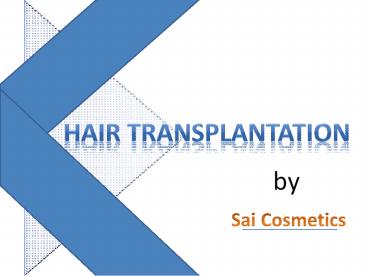Hair Transplant Surgery by Sai Cosmetics - PowerPoint PPT Presentation
Title:
Hair Transplant Surgery by Sai Cosmetics
Description:
It is a surgical technique that removes hair Follicles from one part of the body, called the 'donor site', to a bald or balding part of the body known as the 'recipient site'. – PowerPoint PPT presentation
Number of Views:24
Slides: 10
Provided by:
Username withheld or not provided
Category:
Medicine, Science & Technology
Tags:
Title: Hair Transplant Surgery by Sai Cosmetics
1
Hair Transplantation
by
Sai Cosmetics
2
Do you have Hair loss?
- If yes it is include following symptoms-
- bleeding.
- infection.
- swelling of the scalp.
- bruising around the eyes.
- a crust that forms on the areas of the scalp
where hair was removed or implanted. - numbness or lack of sensation on the treated
areas of the scalp. - itching.
- inflammation or infection of the hair follicles
(folliculate).
3
What is Hair Transplant?
Hair transplantation is a surgical technique
that removes hair Follicles from one part of the
body, called the 'donor site', to a bald or
balding part of the body known as the 'recipient
site'. The technique is primarily used to
treat male pattern baldness. In this minimally
invasive procedure, grafts containing hair
follicles that are genetically resistant to
balding, (like the back of the head) are
transplanted to the bald scalp
4
Why to do Hair Transplant?
Hair transplantation is a surgical technique that
removes hair follicles from one part of the body,
called the 'donor site', to a bald or balding
part of the body known as the 'recipient site'.
The technique is primarily used to treat male
pattern baldness. Hair transplantation, using
the newest FUE and FUT methods, is offered at Sai
Cosmetics at our many locations.
5
What are the Risk Factor?
Hair transplantation is an extremely safe
out-patient procedure that is normally without
significant risks or complications. However, as
is the case in any surgery, there are risks, and
these are always presented and discussed in
detail at your personal consultation with our
qualified surgeon.
6
Bleeding- Some bleeding is normal and will stop
with simple pressure. Persistent bleeding occurs
in about one in a few hundred cases. Additional
stitching is rarely required. Pain- Pain is
usually rare and fairly minimal. Half of our
patients do not require any pain relievers, and
the others take Solpadine or Panadol for a few
days. Numbness- Some transient numbness is
inevitable, usually in the donor area, and
generally lasts from 3 to 18 weeks. It is rarely
troublesome or long-lasting. Hiccups- Hiccups may
occur after surgery. The cause is not known, but
hiccups seem to occur more frequently after hair
transplantation than scalp reduction. The
incidence of this complication is about 5. It
usually lasts several hours to several days
7
Itching- Some itching commonly occurs but is
rarely troublesome and lasts only a few days.
Shampooing the hair daily will help the
discomfort. Swelling- There is rarely any
swelling. When there is, it can affect the
forehead and the area around the eyes and last 1
to 2 days. In about 1 of cases, a black eye
can develop. Infection- This happens in one in
several thousand cases and is easily treated with
antibiotics. Scarring- Keloid scarring occurs
only in pre-disposed individuals, and even more
rarely (one in one thousand cases) this scarring
can cause a ridging effect. Cysts- One or more
cysts may occur in the recipient area when many
grafts have been inserted. They usually disappear
by themselves after a few weeks or immediately
with various simple treatments
8
Prevention?
- DOs
- DO have someone drive you home after the
procedure. The anesthetic sedative administered
to relieve pain and help you relax during the
procedure takes time to wear off, and it probably
has not worn off yet by the time the surgery is
done. So driving yourself home while the sedative
is still kicking is not advisable at it might
pose a danger to both you and to others. - DONTs
- DONT expose yourself to direct sunlight
immediately after and even a few days after the
procedure, especially if the scalp is still
swollen. If going outdoors in daytime is
unavoidable, wear a hat. - DONT touch or fidget with the newly-grafted
scalp. A little itching and some soreness are
normal side effects, so picking at or rubbing the
sore scalp might result to the new grafts falling
out before they can have a chance to grow.
9
THANK YOU !!!!!































